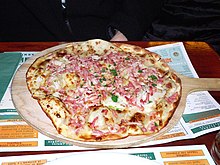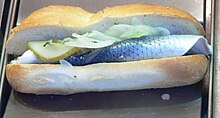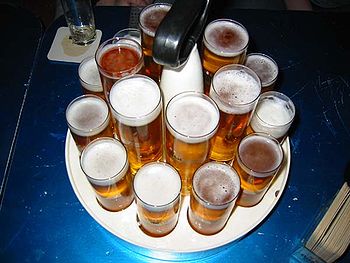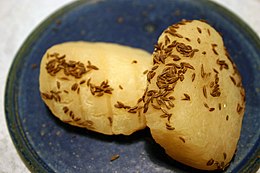Portal:Germany/Selected cuisine
This subpage is used on Portal:Germany, where it randomly shows one of the following selections:

Schweinshaxe (German pronunciation: [ˈʃvaɪns.haksə] ⓘ), in German cuisine, is a roasted ham hock (or pork knuckle). The ham hock is the end of the pig's leg, just above the ankle and below the meaty ham portion. It is especially popular in Bavaria as Schweinshaxn [ˈʃvaɪns.haksn̩] or Sauhax(n) [ˈsaohaks(n̩)]. A variation of this dish is known in parts of Germany as Eisbein, in which the ham hock is pickled and usually slightly boiled.
Schweinshaxe is one of the formerly typical peasant foods, in which recipes were composed to make inexpensive and tough cuts of meat more palatable (see, for beef, the popular Sauerbraten). Such inexpensive cuts usually require long periods of preparation. The meat is sometimes marinated for days, and in the case of big cuts up to a week. The Schweinshaxe is then roasted at low temperatures, typically—depending on size—for two to three hours. (Full article...)

Westphalian ham (German: Westfälischer Schinken) is a ham that was originally produced from acorn-fed pigs raised in the forests of Westphalia, Germany. The resulting meat is dry cured and then smoked over a mixture of beechwood and juniper branches.
The hams are prepared for consumption solely by the process of smoking, which preserves them, and are typically eaten thinly sliced in their preserved state without additional cooking. (Full article...)

Rinderbraten, is a dish of German origin whose name means "beef roast". It is made from a large round of beef, stuffed with pork fat that has been rolled in a combination of salt, red pepper, brown sugar, allspice, and cloves. The round is then submerged in brine for up to six weeks, then boiled, and then simmered, with the blackened outer layer of beef and fat removed and cinnamon sprinkled over it before serving. (Full article...)

Flammekueche (Alsatian), Flammkuchen (Standard German), or tarte flambée (French), is a speciality of the region of Alsace, German-speaking Moselle, Baden and the Palatinate. It is composed of bread dough rolled out very thinly in the shape of a rectangle or oval, which is covered with fromage blanc or crème fraîche, thinly sliced onions and lardons.
The name of the dish varies in local dialects; it is called Flàmmeküeche, or Flàmmaküacha in Alsatian, or Flammkuche in Lorraine Franconian – compare (Standard) German Flammkuchen. All these names translate as "pie baked in the flames". Contrary to what the direct translation would suggest, tarte flambée is not flambéed but is cooked in a wood-fired oven. (Full article...)

Sauerbraten (pronounced [ˈzaʊ̯ɐˌbʁaːtn̩] ⓘ) is a traditional German roast of heavily marinated meat. It is regarded as a national dish of Germany, and is frequently served in German-style restaurants internationally. It can be cooked from a variety of meats, most often from beef, but also from chicken, lamb and mutton, pork and horse. Before cooking, the raw meat is marinated for 5 to 15 days in a mixture of wine or vinegar, water, herbs, spices, and seasonings. Usually, tougher cuts of meat, such as rump roast or bottom round of beef, are used, and the long marinating tenderizes the meat. A Sauerbraten dinner is almost always accompanied by a hearty gravy resulting from its roasting and is most often served with potato pancakes (Kartoffelpuffer), potato dumplings (Kartoffelklöße), or Spätzle.
Ingredients used in the marinade, and accompaniments served with sauerbraten, vary across regions. Regional variants of the dish include those from Baden, Franconia, Thuringia, Rhineland, Saarland, Silesia, and Swabia. (Full article...)

Bremer Klaben, or just Klaben, is a type of Stollen from Bremen, Germany. This celebrated bread, famous in Northern Germany, is traditionally eaten during the Christmas season. It is said that Bremer Klaben tastes especially good when it is baked two weeks before serving. It has a shelf life of several months. (Full article...)

German wine is primarily produced in the west of Germany, along the river Rhine and its tributaries, with the oldest plantations going back to the Roman era. Approximately 60 percent of German wine is produced in the state of Rhineland-Palatinate, where 6 of the 13 regions (Anbaugebiete) for quality wine are situated. Germany has about 103,000 hectares (252,000 acres or 1,030 square kilometers) of vineyard, which is around one tenth of the vineyard surface in Spain, France or Italy. The total wine production is usually around 10 million hectoliters annually, corresponding to 1.3 billion bottles, which places Germany as the eighth-largest wine-producing country in the world. White wine accounts for almost two thirds of the total production.
As a wine country, Germany has a mixed reputation internationally, with some consumers on the export markets associating Germany with the world's most elegant and aromatically pure white wines while other see the country mainly as the source of cheap, mass-market semi-sweet wines such as Liebfraumilch. Among enthusiasts, Germany's reputation is primarily based on wines made from the Riesling grape variety, which at its best is used for aromatic, fruity and elegant white wines that range from very crisp and dry to well-balanced, sweet and of enormous aromatic concentration. While primarily a white wine country, red wine production surged in the 1990s and early 2000s, primarily fuelled by domestic demand, and the proportion of the German vineyards devoted to the cultivation of dark-skinned grape varieties has now stabilized at slightly more than a third of the total surface. For the red wines, Spätburgunder, the domestic name for Pinot noir, is in the lead. (Full article...)

A Fischbrötchen (listen) (pl. "Fischbrötchen", lit. fish roll) is a sandwich made with fish and other components such as fresh white or dried onions, pickles, remoulade, creamy horseradish sauce, ketchup, or cocktail sauce. It is commonly eaten in Northern Germany, due to the region's proximity to the North Sea and Baltic Sea.
A common preparation is made with bismarck herring or soused herring. Other varieties use Brathering, rollmops, European sprat, salmon, smoked Atlantic mackerel, fried Atlantic cod, and other fish varieties (e.g., fish burgers). Prawns are sometimes used, as are various other species of food fish. Fischbrötchen are commonly served at fast food stands or take-out restaurants. (Full article...)

Bratwurst (German: [ˈbʁaːtvʊʁst] ⓘ) is a type of German sausage made from pork or, less commonly, beef or veal. The name is derived from the Old High German Brätwurst, from brät-, finely chopped meat, and Wurst, sausage, although in modern German it is often associated with the verb braten, to pan fry or roast. Beef and veal are usually incorporated amongst a blend often including pork. Beef or veal is usual in halal and kosher Bratwurst sausages, which never include pork for religious reasons. (Full article...)

Beer (German: Bier pronounced [biːɐ̯] ⓘ) is a major part of German culture. Only water, hops, and malt are permitted as ingredients, and beers not exclusively using barley-malt, such as wheat beer, must be top-fermented.
In 2020, Germany ranked third in Europe in terms of per-capita beer consumption, behind the Czech Republic and Austria. (Full article...)

Handkäse (pronounced [ˈhantkɛːzə]; literally: "hand cheese") is a German regional sour milk cheese (similar to Harzer) and is a culinary speciality of Frankfurt am Main, Offenbach am Main, Darmstadt, Langen, and other parts of southern Hesse. It gets its name from the traditional way of producing it: forming it with one's own hands.
Handkäse is a small, translucent, yellow cheese with a pungent aroma that some people may find unpleasant. It is sometimes square, but more often round in shape. (Full article...)

Currywurst (German: [ˈkœʁiˌvʊɐ̯st] ⓘ) is a fast food dish of German origin consisting of steamed, fried sausage, usually pork (German: Bratwurst), typically cut into bite-sized chunks and seasoned with curry ketchup, a sauce based on spiced ketchup or tomato paste topped with curry powder, or a ready-made ketchup seasoned with curry and other spices. The dish is often served with french fries. (Full article...)
Knödel (German: [ˈknøːdl̩] ⓘ; sg. and pl.) or Klöße (German: [ˈkløːsə] ⓘ; sg.: Kloß) are boiled dumplings commonly found in Central European and East European cuisine. Countries in which their variant of Knödel is popular include Austria, Bosnia, Croatia, Czechia, Germany, Hungary, Poland, Romania, Serbia, Slovakia and Slovenia. They are also found in Scandinavian, Romanian, northeastern Italian cuisine, Ukrainian, Belarusian and French (Alsatian) cuisines. Usually made from flour, bread or potatoes, they are often served as a side dish, but can also be a dessert such as plum dumplings, or even meat balls in soup. Many varieties and variations exist. (Full article...)

Maultaschen (German: [ˈmaʊ̯lˌtaʃn̩] ⓘ; singular Maultasche , lit. 'mouth bags') are a kind of large meat-filled dumpling in Swabian cuisine. They consist of sheets of pasta dough filled with minced meat, smoked meat, spinach, bread crumbs and onions and flavored with various herbs and spices (e.g. pepper, parsley and nutmeg). Maultaschen are typically 8–12 centimetres (3–4+1⁄2 inches) across. They are square or rectangular in shape.
On 22 October 2009, the European Union recognized Maultaschen (Schwäbische Maultaschen or Schwäbische Suppenmaultaschen) as a 'Protected Geographical Indication (PGI)' and remarked that the dish is significant to the cultural heritage of Baden-Württemberg. This measure provides protection to the integrity of the dish, mandating that genuine Maultaschen are only produced in Swabia, a historical region that was incorporated into the modern German states of Baden-Württemberg and Bavaria. (Full article...)

Bayrisch Kraut (Bavarian cabbage) is a traditional Bavarian dish. It is made of shredded cabbage cooked in beef stock with pork lard, onion, apples, and seasoned with vinegar. It is typically served with bratwurst or roast pork. In German cuisine it is an alternative to sauerkraut. (Full article...)

Magenbrot (German: [ˈmaːɡn̩ˌbʁoːt] ⓘ) is a small, sweet glazed biscuit that shares many similarities with a gingerbread cookie. The name of the dish directly translates to "stomach-bread" as it is believed to help improve digestion. This recipe first appeared in Swiss cooking books in the late 18 century. It is usually sold in Christmas markets in northern Switzerland and southern Germany. It is known by many names including Honigkuchen, Gewürzkuchen, or Kräuterbrot. (Full article...)

Due to its centuries-old history as a major port town the cuisine of Hamburg is very diversified and sapid as ingredients' supply was safe. Until the 20th century, the cuisine of Hamburg was predominantly characterized by the extensive choice of different kinds of fish from the river Elbe and the nearby Baltic Sea. The region of Vierlande supplied Hamburg with fresh vegetables. Fruit came from the area Altes Land and until industrialization the neighbourhood of Wilhelmsburg was considered the ‘milk isle’ of Hamburg. International trade in the Port of Hamburg made spices and exotic nutrition items from India and South America available since the 16th century, which were soon incorporated into civic kitchens.
On this basis, the cuisine of Hamburg developed which regrettably lost some of its characteristics nowadays due to the supraregional harmonization of the North German cuisine. But due to its high economic importance, Hamburg does feature many internationally recognized gourmet restaurants from which 11 were repeatedly awarded with a Michelin star in 2010. (Full article...)

Mett (German: [mɛt] ⓘ), also known as Hackepeter (Northern Germany, Eastern Germany, Bavaria and Berlin), is a preparation of minced raw pork seasoned with salt and black pepper that is popular in Germany. It is frequently spread on halves of a bread roll, with raw onion optionally on top. Since the 1950s mett has also been offered as a buffet dish decoratively formed into the shape of a hedgehog, with raw onion "spines". German law forbids mett being sold with a fat content exceeding 35%. (Full article...)
Berliner Weisse (German: Berliner Weiße, pronounced [bɛʁˌliːnɐ ˈvaɪ̯sə] ⓘ) is a cloudy, sour beer of around 3.5% alcohol by volume. It is a regional variation of the wheat beer style from Northern Germany, dating back to at least the 16th century. It can be made from combinations of malted barley and wheat, with the stipulation that the malts are kilned at very low temperatures or even air-dried to minimise colour formation. The fermentation takes place with a mixture of yeast (Saccharomyces cerevisiae and Brettanomyces) and lactic acid bacteria, a prerequisite that creates the lactic acid taste, a distinguishing feature of Berliner Weisse. By the late 19th century, Berliner Weisse was the most popular alcoholic drink in Berlin, with up to fifty breweries producing it. By the late 20th century, there were only two breweries left in Berlin producing the beer. (Full article...)

Pomeranian cuisine generally refers to dishes typical of the area that once formed the historic Province of Pomerania in northeast Germany and which included Stettin (now Szczecin) and Further Pomerania. It is characterised by ingredients produced by Pomeranian farms, such as swede (Wruken) and sugar beet, by poultry rearing, which has produced the famous Pomeranian goose, by the wealth of fish in the Baltic Sea, rivers and inland lakes of the Pomeranian Lake District, and the abundance of quarry in Pomeranian forests. Pomeranian cuisine is hearty. Several foodstuffs have a particularly important role to play here in the region: potatoes, known as Tüften, prepared in various ways and whose significance is evinced by the existence of a West Pomeranian Potato Museum (Vorpommersches Kartoffelmuseum), Grünkohl and sweet and sour dishes produced, for example, by baking fruit.
Pomeranian farmers were self-sufficient: crops were stored until the following harvest, meat products were preserved in the smoke store of the home, or in the smokeries of larger villages such as Schlawin. Fruit, vegetables, lard and Gänseflomen were preserved by bottling in jars. Syrup was made from the sugar beet itself. (Full article...)
Saxon cuisine encompasses regional cooking traditions of Saxony. In general the cuisine is very hearty and features many peculiarities of Mid-Germany such as a great variety of sauces which accompany the main dish and the fashion to serve Klöße/Knödel as a side dish instead of potatoes, pasta or rice. Also much freshwater fish is used in Saxon cuisine, particularly carp and trout as is the case throughout Eastern Europe. The rich history of the region did and still does influence the cuisine. In the blossoming and growing cities of Dresden and Leipzig an extravagant style of cuisine is cherished as exemplified by crab as an ingredient in Leipziger Allerlei. Other regions where the people had to work really hard to yield some harvest and were really poor like in the Ore Mountains peasant dishes play a major role and famous dishes originating there are e.g. potatoes with quark, potato soup or potato with bread and linseed oil. Also in the region Vogtland there were many peasants but they were wealthier and that's why in this region the Sunday roast is a tradition that is nowadays still lived up to. (Full article...)

Königsberg marzipan is a type of marzipan traditionally produced in the former German city of Königsberg (now Kaliningrad, Russia). Königsberg's first marzipan production was established by the Pomatti brothers in 1809, who became confectioners of the Royal Prussian Court. They were joined by Sterkau, Petschliess, Liedtke, Siegel, Steiner, Gehlhaar, Plouda in Kneiphof, as well as Wald in Berlin and Schwermer in Bad Wörishofen. Königsberg marzipan is known for its flamed surface, which results in a golden-brown finish. It contains rose water and is often filled with jam. These characteristics distinguish it from the more common Lübeck Marzipan, which also frequently comes in more elaborate forms. (Full article...)